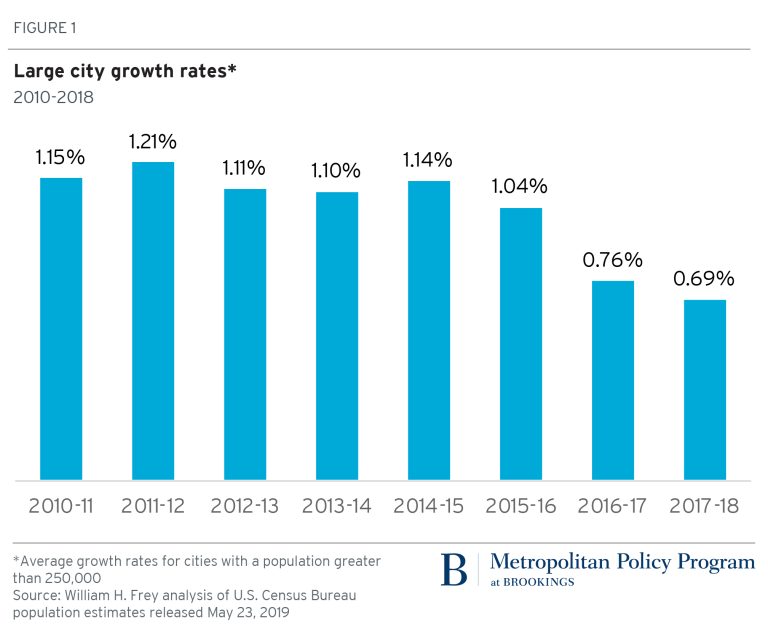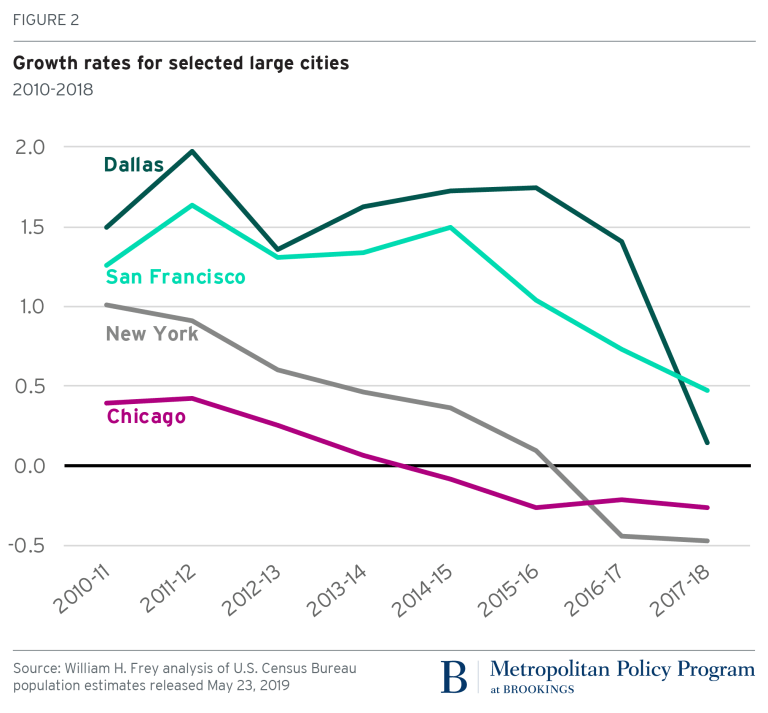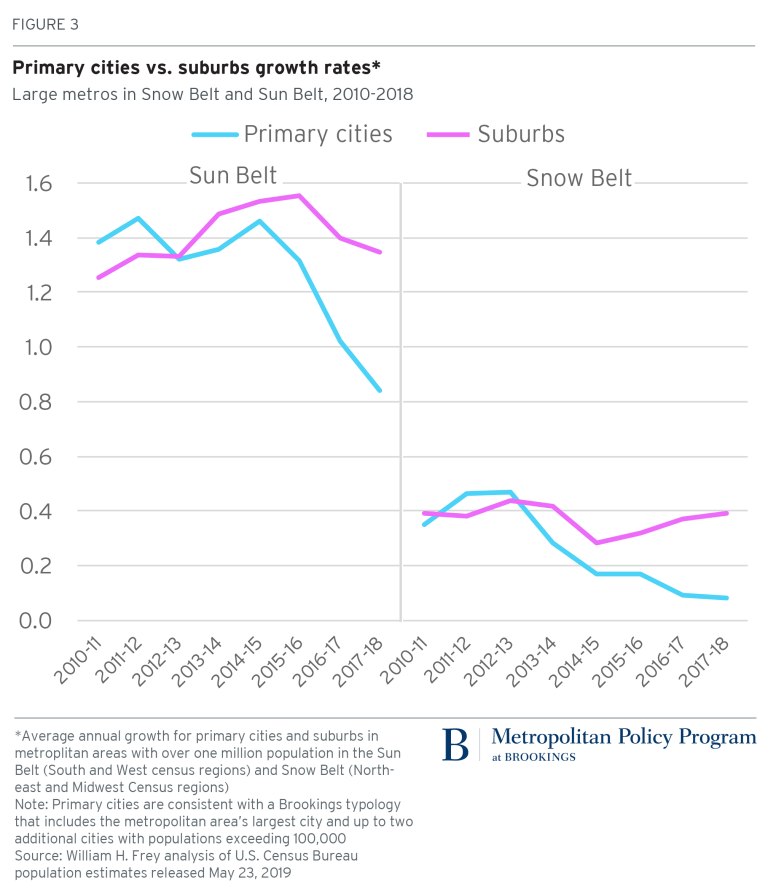It's official. The "back to the city" movement seems to be winding down, at least for the foreseeable future. For years now in North American ministry circles, much discussion has occurred over the rise of city populations. However, trends seem to be shifting once again toward the suburbs.
New research by the Brookings Institute confirms a nationwide slowing of urban growth. The annual rate of growth for many of the largest US cities has steadily declined since 2011-2012. According to the report,
"[Numbers] show that the average annual growth for the nation’s 87 cities with populations over a quarter million have slipped to 0.69% in 2017-2018—down from 0.76% the previous year, and from 1.21% in 2011-2012, the highest average growth since the Great Recession."
The Brookings report notes that the slowdowns are most pronounced in America's biggest cities.
In fact, according to the data, a number of the largest US cities are actually losing population. Brookings indicates that New York City—which was one of the largest gainers at the beginning of the decade—is now losing population annually. While some of this population loss in the biggest cities is landing in other cities, this urban growth is currently the exception, not the rule.



Brookings reports, "One consequence of big city population declines is the return of suburbanization, which was muted in the earlier years of this decade." The report compares trend lines for both urban and suburban areas, demonstrating the re-emergence of suburban growth around the middle of the decade. The report continues, "In both regions, city growth exceeded suburban growth in the early years of this decade, where Sun Belt growth in both cities and suburbs exceeded Snow Belt growth. As the decade wore on, city growth declined in both mega-regions while suburban growth remained higher."
What does this mean for ministry?
These shifting population trends matter when it comes to the Great Commission. For a number of years now, the general trend in North American missions has been to beat the drum for cities. Dozens of books on city missionary methods have been written, and the number of blog articles and hot takes (including my own) dwarf the pile of books.
However, when people are on the move, the goal posts are constantly shifting. Ministry is dynamic because communities are dynamic. While the particulars of strategy are most often confined to the specific local context, there are at least three high-level insights that merit a mention.
1. This does not mean we should retreat from the cities.
“We still have some catching up to do concerning the Great Commission in urban settings.”
While the city boom over the last decade or so was a cause to rally toward cities, it was not the only reason. It would be easy to think a shift in population numbers back toward suburbs means we should shift our focus away from cities. This is flawed logic.
Historically, cities have been underserved by evangelical missions efforts since the 1920s. When America began to suburbanize for the first time, our churches were often the ones at the front of the line out of the city. Because of this preference for the suburbs, evangelical Christianity is often underrepresented in our city centers, and these places need the gospel. Most cities are still growing, just not as fast as they were and not as fast as their surrounding suburbs. We still have some catching up to do concerning the Great Commission in urban settings.
2. This does mean the suburbs matter.
I hear people talk all the time about church planters who are going to suburbs as though their work is somehow less important than planting in city centers. Spend enough time around church planter equipping cohorts, and you get the sense that guys headed out to the suburbs to plant have taken the easy route. While planting in cities is certainly a challenge, there are legitimate reasons to plant in the suburban ring as well. There may be more evangelical church footprints in the suburban quarters of your metro, but that does not mean there are enough. Suburban growth will most likely outpace church growth.
If the Great Commission means we go where the people are, then the suburbs matter. Furthermore, we have the benefit of an existing presence in many of our suburbs. In many cases, we are positioned well to receive new suburban growth. This becomes a gospel opportunity for those established churches that already exist in the suburbs. However, and this is important, we have to realize that new people and a new decade means a new culture.
“There may be more evangelical church footprints in the suburban quarters of your metro, but that does not mean there are enough. Suburban growth will most likely outpace church growth.”
3. This does not mean a return to previous methods.
It would be easy for us to assume, that suburban population growth today will be reached in the same methods as the suburban populations of the previous era. Making such an assumption would be a grave mistake.
Suburban growth today will have different cultures than the one that made suburban church methods successful in the past. As older millennials move their new families out into the suburbs, we must realize the prevailing narrative for this group is different. They will have different values—and possibly a different worldview—than the parents they left behind when they moved into cities as young, professional singles.
Even more important is the staggering diversity that is now making a home in our suburbs. In previous decades, the suburbs were more homogeneous than what we will find moving forward. A significant portion of the new growth headed to our classic suburban areas is foreign-born because the suburban environment makes it easier for ethnic enclaves to form. These groups will need their own cultural manifestations of the gospel and may need churches planted in different languages and cultures.
Our church growth boom and the rise of the megachurch rode largely on the back of a suburban ministry model that was primarily attractional. We cannot, however, be fooled into thinking that new suburban growth will have the same estimation of our old methods. This growth is not moving into 1990 suburban Houston or Atlanta. It's moving into 2019 suburbs.
Keelan Cook is the Associate Director of the Center for Great Commission Studies at Southeastern Baptist Theological Seminary and former Associate Director of UBA. His primary areas of ministry focus include urban missiology, church planting, church revitalization, and unreached people groups.



